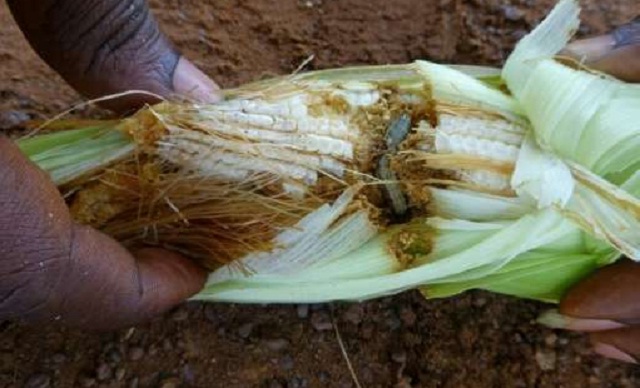
– Small but dangerous –
The life cycle of Spodoptera frugiperda is only about six weeks, but it packs an outsized punch.
In the final two weeks, the armyworm caterpillar metamorphoses into a moth able to cover up to 100 kilometres (60 miles) in a night.
Each female can lay up to 1,500 eggs, ensuring an exponential growth of foot soldiers with a remarkable ability to adapt.
Maize is the armyworm’s favourite food, but the caterpillar is a voracious and indiscriminate consumer, able to chew on at least 80 different crops.
In Kenya, efforts were made to stop its spread by alternating maize with other crops between seasons, but the caterpillar simply switched to bananas, millet and sorghum before returning to maize when the next harvest was served up.
The invasion has taken everyone by surprise in Kenya, as elsewhere in the continent.
At first, the creature wasn’t even recognised. It was mistaken for the local, less voracious and easier-to-combat “African armyworm” — another brownish, caterpillar the size of a child’s pinky.
Once correctly identified, it was a case of try anything, for Ngoda and his neighbours at the centre of the counter-insurgency.
“Some are using detergents, and they have actually told us it works, farmers have also used other methods like ash (sprinkled on the cobs) — it worked for some — and some farmers were putting soil in the (hole on top) of the crop to suffocate the pest,” said Brigid Cheloti, an agriculture ministry official in Vihiga County in western Kenya.
– Inadequate armoury –
Pesticides, potentially, are another weapon. Drawing on Latin America’s experience some have been identified that are effective and available locally, said Patrick Amuyunzu of the Agrochemicals Association of Kenya (AAK).
However, the armyworm quickly develops resistance to prolonged use of the same pesticide, which must therefore be changed regularly to be effective.
 The Independent Uganda: You get the Truth we Pay the Price
The Independent Uganda: You get the Truth we Pay the Price



